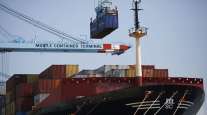Intermodal Cargo Falls in 4Q for First Time Since 2009

Intermodal freight in the fourth quarter declined for the first time since 2009 on a year-over-year basis, industry experts said, hurt by factors such as low fuel prices that helped competing truckers, a weaker economy and elevated inventories.
The decline, based on Association of American Railroads data published last week, was 0.4% in North American intermodal freight and 1% for U.S.-based railroads, Credit Suisse analyst Allison Landry said. The shift was first signaled last month in her investor note, which predicted the decline in intermodal — a bastion of rail freight growth earlier in 2015 and in prior years.
The decline, the first in 23 consecutive quarters, followed 2015 increases of 3.4% in the third quarter, 4.5% in the second and 2% in the first. For all of 2015, intermodal accounted for 48% of all rail shipments and increased about 2% for the full year, while all other rail shipments declined 6.1%. The 2015 total still set another full-year record.
“There are a few different things driving the change,” Landry told Transport Topics on Jan. 7. “It’s hard to figure out which of the factors is having the largest impact.”
Looser capacity in 2015 truckload markets compared with 2014 was accompanied by the elevated inventories cited by railroads presenting at Credit Suisse’s investor conference last month, she said. A 30% drop in diesel prices also helped. Another factor: “We didn’t see a peak season for international container shipments,” which in past years has been a staple in the fourth quarter.
Landry and FTR consultant Larry Gross, a former intermodal executive, noted that in 2015 shipping patterns were disrupted by the West Coast port delays that were concentrated in the early months.
The result of those disruptions was that international intermodal shipments peaked in May as shippers chose to move freight far in advance of the typical fall peak, Gross said.
“Domestic rail intermodal is being impacted by the cheaper price of diesel fuel,” American Trucking Associations Chief Economist Bob Costello said. “That makes trucking more competitive with rail intermodal. With that said, the same factors that have been a drag on truck freight recently, including the inventory glut and soft manufacturing activity, are also impacting rail intermodal.”
He continued: “Currency changes and economic weakness with several of our large trading partners continue to impact international trade, which obviously has a big impact on international container volumes. This is especially true with exports, which suffered in 2015.”
Because AAR statistics don’t provide a breakdown of international versus domestic intermodal, Landry said it isn’t yet fully clear how much of the drop-off could be attributed to which type of truck-rail freight. The Intermodal Association of North America hasn’t yet published its quarterly report that delineates domestic and international trends.
It’s unclear whether the fourth-quarter results are to be a trend or a one-time event, the analysts said.
“It will be really interesting to see how intermodal plays out given recent rail-service improvements,” Landry said.
“We are certainly not starting with a lot of visibility into 2016. We are not starting out on such a great note with all the negative macroeconomic commentary,” she said.
Chinese stocks were pummeled last week, and in the United States, the closely watched Institute for Supply Management’s index declined in December to 48.2, the weakest since June 2009.
“Shippers are still cognizant of intermodal advantages,” Gross told TT. “There could be a real tightening of capacity, but that will not occur until late 2016 or early 2017,” when mandatory electronic logging devices and other new federal regulations begin to take effect. If there are delays in the effective date of regulations, current conditions will persist, he said.
Gross said international intermodal could grow this year because solid U.S. consumer markets could stimulate imports.
Landry believes that intermodal will benefit as current capacity trends in trucking will shift sometime this year so that the excess capacity that is reflected in weak truck orders and used-truck prices is absorbed.
Even with crude prices at a 12-year low, intermodal still offers savings for shippers, she said, compared with all highway moves.
IANA President Joni Casey said that intermodal shipments in trailers have continued to weaken, but there have been favorable signs in domestic container shipments in October and November, continuing a steady 4% growth pace since June. On the international front, intermodal shipments fell in October and improved in November, she said.
AAR didn’t respond to requests specific to intermodal trends. However, John Gray, the head of policy and economics, said in a statement, “Weaknesses in energy and manufacturing, as well as world economic softening, had a negative impact on both carload and intermodal traffic in 2015.”




